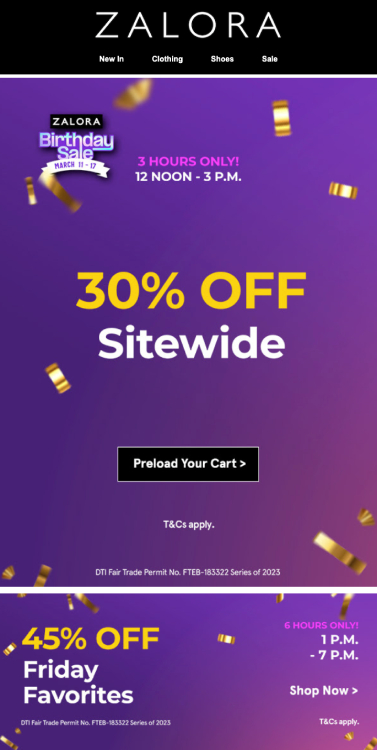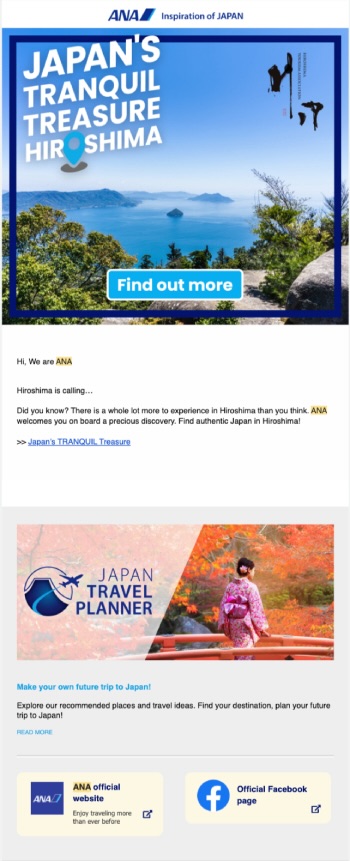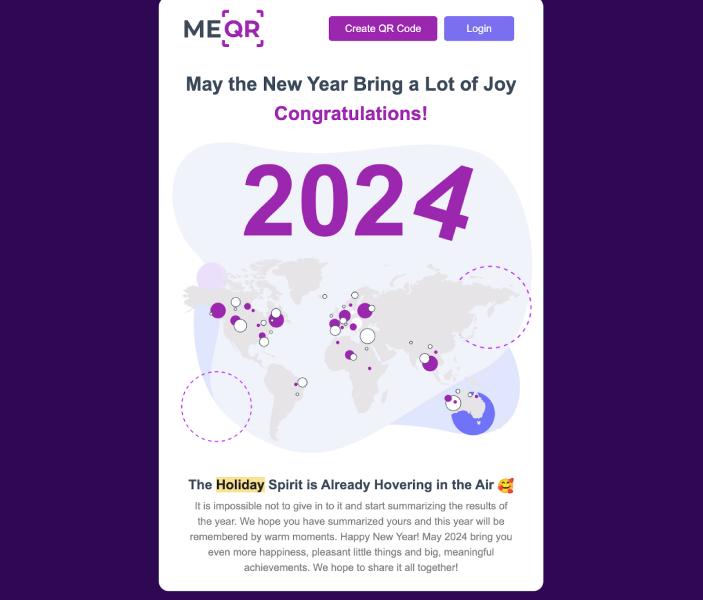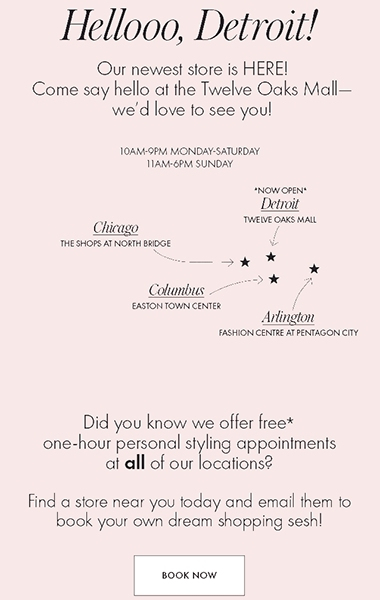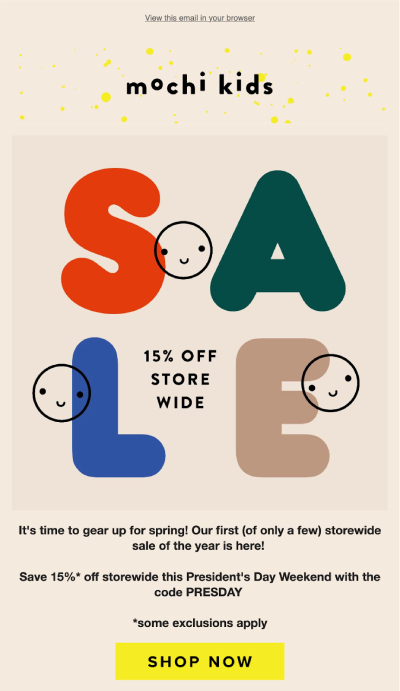Bulk email marketing (also called “mass email marketing”) is one of the oldest forms of digital marketing—mainly because it’s enduringly effective. If you open your inbox on any given day, you’ll likely find a dozen or so marketing emails, from newsletters to limited-offer coupons. That’s because emails remain a meaningful way to reach your audiences. Here, we’ll look into bulk email marketing and how it can serve your small business.
What Is Bulk Email Marketing?
At its simplest, bulk email marketing is sending emails to many audiences simultaneously with the sole intent of marketing your brand. If you’ve ever received an email from a brand or company telling you about their products or services, you probably already have a general idea of what bulk or mass emails are. They’re a proven and effective way of reaching your audience and building your brand presence.
Here’s an example of a bulk email campaign from the retail app Zalora promoting a sale. They’re sent out to everyone in Zalora’s customer community. (Source: Zalora)
Bulk emailing vs permission-based email marketing: Both strategies are similar in that they send emails to mass audiences. However, with permission-based email marketing, you’re sending specifically to audiences who opted in to receive your email content, e.g., your monthly newsletter. In contrast, bulk emails can be sent to any email address related to your business in any way, for instance, to a customer who has previously bought from your store.
It’s also important to know the differences in purpose between mass and permission-based emails. While the former can get messages across to thousands of people quickly, targeted emails can sometimes be more impactful because your recipients consciously invite you to their inboxes. These are particularly effective for nurturing leads through the sales funnel. Still, both play important roles in your email marketing strategy.
However, due to regulations like the US CAN-SPAM act and the EU’s General Data Protection Regulation, permission-based emails are increasingly becoming the industry standard. While bulk email sending is still generally allowed, it’s a good idea to do it sparingly and with caution.
Why Bulk Emails Are Effective
If you’ve ever wanted to get a message across to hundreds or thousands of people, there’s no reason not to try mass email marketing. It’s the same kind of reach as broadcasting an ad on TV or radio, only at much lower costs. And unlike those two channels, or even social media, emails are delivered to a more focused audience since you won’t be competing with dozens of other brands. Once audiences open your email, you’ll have their attention for the whole page.
In a nutshell, mass emails are a cost-effective way to get your message across thousands of people at once. But they’re also effective for a few other reasons:
- They’re measurable: One of the best things about email marketing is it allows you to measure your campaigns’ effectiveness precisely and immediately. After sending an email campaign, you can instantly see how many people opened it, how many clicked on your links, how many unsubscribed, and other relevant stats. Use this data to build better campaigns in the future.
- They’re versatile: Whether you’re welcoming new customers to your business or telling former customers about your upcoming sale, a mass email can get the message across quickly, easily, and effectively. They also allow for longer messages (vs social media posts or digital ads) and give you more space to be creative.
- They can get people to take action: When audiences watch a TV commercial, they aren’t able to take action immediately afterward. But with emails, they can. After people read your email, they can follow your call to action right away, whether it’s visiting your website, signing up for an event, or completing a survey.
When to Use Mass Emails
Now that you know the biggest benefits of mass emails, you’ll need to understand how to send them strategically to maximize their impact. Sending too many emails too often is never a good idea. Just imagine if you were on the receiving end—you’d probably unsubscribe at your first opportunity.
While it can vary for each business, the sweet spot is usually sending two to three times a week, which is how often customers like to hear from brands, and to fewer than 5,000 contacts a day. This is enough to ensure email providers don’t mark you as spam. Make sure each email you send contains a meaningful message and a desired action for the recipient to take. Additionally, look for instances where mass emails are most effective and capitalize on these topic angles:
For Brand Awareness Campaigns
You can think of bulk emails as the posters or billboards of the email marketing world. This is because they aren’t sent to specific, targeted audience sets, but to the general masses. This makes them a good option for brand awareness campaigns, or when you’re simply letting people know about your brand and encouraging them to learn more about your product, but not necessarily to complete a purchase.
Mass emails are a good option for getting the word out about your business to as many people as possible, as efficiently as possible.
Here’s an example of a brand awareness email campaign from ANA Airlines. While it has some links, it doesn’t expressly invite readers to complete one specific action. (Source: ANA Airlines)
For Holiday Greetings
Another good case for sending emails in bulk is for national holiday greetings, like on New Year’s Day or Thanksgiving. These also don’t require you to segment your recipients or to elicit a response or action from them. However, they can help keep your brand top of mind.
Holiday campaigns like these can help keep your brand top of mind. (Source: ME-QR)
For General Announcements
If you have general announcements about your business, such as a new store location opening or some store policy changes, mass emails are also a good way to get the word out. This is particularly because email, unlike social media, gives you a more focused and captive audience. And it allows you to monitor how many people opened and read your message.
Mass emails can also send out general announcements like store openings efficiently. (Source: Mailigen)
For Promotions & Sales
If you’re planning a sale or promotion at your store, you want your whole community to know. Aside from posting on social media or putting up posters, sending email blasts should also be part of your campaign strategy. These promotional emails can include a call to action (CTA), for instance, to visit your physical or online store.
If you have a store sale or promotion, emails can get the word out to your community instantly, like this example. (Source: Mochi Kids)
For Product Catalogs
Remember those product catalogs you used to receive in the mail from your favorite brands? That format of the past can work as a bulk email today. Similar to brand awareness campaigns, product catalog emails let customers know what your business offers and can include links to your products. These can also work as product updates (say if your product is a tech software) or to showcase new products at your store.
Here’s an example of a type of product catalog email from Netflix, whose product is its films and series content. Netflix sends it out to all its subscribers. (Source: Netflix)
When should you send bulk emails? According to the email platform Moosend, the optimal time to send emails is on Tuesdays and Thursdays between 8 a.m. and 9 a.m. This is when emails have the highest open rate. In contrast, the lowest open rates are during the weekends (no surprise there), or after 6 p.m.
Bulk Email Best Practices: Do’s & Don’ts
While bulk email sending is generally simple, it still needs to be strategic to be effective. It’s not simply a matter of building your email and then sending it out to your contact list. Like any marketing strategy, bulk emailing has its own best strategies and practices to follow. Here are some of the most important do’s and don’ts to follow with bulk emailing:
Bulk Email Do’s | Bulk Email Don'ts |
|---|---|
|
|
Essential Bulk Email Tools
If you plan to do mass email campaigns, you’ll need the right tools. There are many email platforms around, and the great news is most won’t cost you a fortune and are simple enough to set up (hint: check out our guide to the best free email platforms to get an idea). Here are the most essential tools you’ll need to send email campaigns:
- Lead capture forms: Before you can start emailing anyone, you’ll need a contact list. The only way to collect them is via lead capture forms, which are forms where people can input their email address and other info. You can place lead capture forms on your business website, social media profiles, or on checkout pages after customers make a purchase.
- Email design tools: Most email platforms already have built-in design tools, but if you want more design freedom or a more branded look, a design platform like Canva, VistaCreate, or Adobe’s Creative Suite are good options. Use them to design email headers, email signatures, or to lay out your emails.
- Email marketing platform: The most important tool in your email campaigns is your email platform. Your platform of choice will depend on your priorities and preferences. For example, Constant Contact is very beginner-friendly, while HubSpot specializes in sales and lead generation. Learn your best options in our guide to the best email marketing software for small businesses.
- Email analytics dashboard: These will also come with your email platform and are necessary to monitor your email campaigns and determine if you need to pivot your strategy. This data will help you create more effective email campaigns in the future.
- Landing pages (optional): While this isn’t essential for all your mass email campaigns, a custom landing page can also be useful. For instance, if you’re announcing a sale or an upcoming event, you can build a landing page that can give your recipients more information.
Frequently Asked Questions
A bulk email is an email campaign sent to hundreds or thousands of recipients at once. They’re often used in marketing and sales, primarily to build brand awareness or advertise announcements like sales and promotions. They’re different from targeted email marketing campaigns in that they’re sent to mass audiences instead of specific targeted audience sets, and they don’t necessarily have a call to action.
Yes. Most email platforms have free plans to start with, including Mailchimp, MailerLite, and Brevo. These platforms let you add hundreds of recipients, build well-designed emails using templates, and monitor your campaign performance, all at no cost. They also have free plans you can upgrade to for even more features.
To send multiple emails simultaneously from one platform, use an email marketing platform like Mailchimp or HubSpot. These platforms specialize in sending marketing or sales emails that you can build, send, and monitor from one platform. Most also have free plans to start with and affordable paid plans for when you need to scale up.
Bottom Line
With the right strategizing, bulk emails (aka mass emails) can be one of your most useful and cost-effective marketing strategies. They’re simple enough to set up, versatile, and can get any message to thousands of audiences instantly. Use them to let your community know of important announcements, promotions, or simply to build brand awareness for your business.
